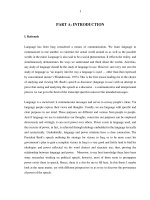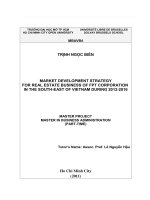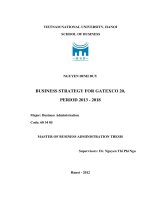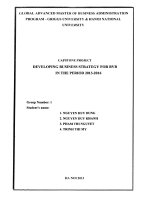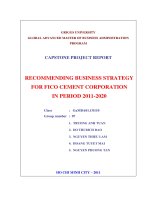Recommended development strategy for Sacombank in period 2011 - 2020
Bạn đang xem bản rút gọn của tài liệu. Xem và tải ngay bản đầy đủ của tài liệu tại đây (1.47 MB, 106 trang )
CAPSTONE PROJECT REPORT
RECOMMENDED DEVELOPMENT
STRATEGY FOR SACOMBANK IN
PERIOD 2011 - 2020
Group No.: 3
LUU HUYNH
HO THI YEN LY
TRUONG VAN HOI
LE HAI HOANG
TRAN DUC HOANG
CLASS: GaMBA01.C0110
2011
GLOBAL ADVANCED MBA PROGRAM (GaMBA01.C0110)
Group No.: 3
Ho Chi Minh City, 2011
GRIGGS UNIVERSITY
Global Advanced Master of Business Administration
RECOMMENDED DEVELOPMENT STRATEGY
FOR SACOMBANK IN PERIOD 2011 – 2020
Class : GaMBA01.C0110
Group : 3
Member : LUU HUYNH
HO THI YEN LY
TRUONG VAN HOI
LE HAI HOANG
TRAN DUC HOANG
Ho Chi Minh City, 2011
Strategic Management – Group 3
Page 2
CONTENTS
ACKNOWLEDGEMENTS 4
LIST OF DIAGRAMS 6
LIST OF TABLES 7
INTRODUCTION 8
CHAPTER 1: RATIONALE OF STRATEGIC MANAGEMENT 10
1.1. Concept, role and process of strategic management 10
1.1.1. Concept and role of business strategy: 10
1.1.2. Strategic management process: 11
1.2. The instruments are used in making business stratery process: 14
1.2.1. Five Forces Model of Michael E.Porter 14
1.2.2. Matrixes are used to analyze, evaluate: 17
Summary of Chapter 1 31
CHAPTER 2: ANALYZE SACOMBANK BUSINESS OPERATION 32
2.1. Introduction to banking services 32
2.1.1. Concept of banking services 32
2.1.2. The value chain of the banking: 35
2.1.3. Current environment of banking sector 36
2.2. Background 37
2.2.1. Establishment and development of Sacombank: 37
2.2.2. Business results of Sacombank 2008-2010: 40
2.3. Analysis of Sacombank business activities 42
2.3.1. Analysis of Five Forces Model of Michael E.Porter in banking 42
2.3.2. Analysis of Sacombank operation environment 46
2.3.3. External Factor Evaluation matrix 51
2.3.4. Analysis of Competitive Profile Matrix 52
2.3.5. Internal analysis 54
2.3.6. Internal Factor Evaluation Matrix (IFE) 60
Summary of Chapter 2 61
Strategic Management – Group 3
Page 3
CHAPTER 3: BUILD DEVELOPMENT STRATEGY FOR SACOMBANK
PHASE 2011-2020 62
3.1. Analysis of banking activities in the coming period 62
3.1.1. Overview of the world economy 62
3.1.2. Forecast development trend of world economy 62
3.1.3. Vietnamese economy 63
3.1.4. Forecast development trend of Vietnamese banking sector: 64
3.2. Sacombank developing target to 2020 65
3.2.1. General target 65
3.2.2. Vision, mission statement, target and core value: 65
3.3. Build and select business development strategy of Sacombank up to 2020: 66
3.3.1. Basis of strategy formulating: 66
3.3.2. Establish strategies from SWOT matrix: 66
3.3.3. SPACE matrix analysis (Strategic Posturing & Action Evaluation) 69
3.3.4. Analysis of Internal factor - External factors (IE): 71
3.3.5. Grand strategy matrix 72
3.3.6. Evaluate and select strategies: 73
3.3.7. QSPM matrix, S – O: 73
3.3.8. QSPM matrix, S – T: 75
3.4. Solutions to implement Sacombank development strategy in 2011 – 2020: . 77
3.4.1. Core business fields 77
3.4.2. Main solution development: 83
3.4.3. Solution Support Team. 88
3.5. Evaluate difficulties and propose solutions to execute strategies: 93
3.6. Implementation Schedule 94
3.7. Resolution: 95
3.7.1. To Government: 95
3.7.2. To State Bank of Vietnam: 95
3.7.3. To Sacombank: 96
Summary of Chapter 3 97
CONCLUSION 98
REFERENCES 99
APPENDIX 100
Strategic Management – Group 3
Page 4
ACKNOWLEDGEMENTS
First of all, we would like to express our appreciation to all professors and staff at
ETC - Nation University Hanoi for giving us chance to obtain knowledge in mordern
advanced business administration. We highly appreciated their support to help us
successfully accomplish the whole program of Global Advanced Master of Business
held by the Center.
We also would like to thank our classmates from GaMBA01.C0110 class who
always supported and encouraged us while completing this paper.
Last but not least, we want to thank Sacombank for its provision of relevant data of
the Company.
The joint paper could not have been completed without the cooperation and hard
work of all members of the Group resulting in deep understanding and high accord
when choosing the topic, gathering information and analyzing them.
Strategic Management – Group 3
Page 5
ABBREVIATIONS
ACB : Asia Commercial Bank
ALCO : Asset Liabilities Committee
ANZ : Australia & New Zealand Bank
ATM : Automatic Teller Machine
BCG : Boston Consult Group matrix
CAR : Capital Adequacy Ratio
EFE : External Factor Evaluation Matrix
IFE : Internal Factor Evaluation Matrix
GDP : Gross Domestic Products
Strategic Management – Group 3
Page 6
LIST OF DIAGRAMS
Diagram 1.1: Five forces Model of Michael E.Porter 14
Diagram 1.2: IEF matrix 20
Diagram 1.3: SPACE matrix 24
Diagram 1.4: IE matrix 27
Diagram 2.1: Model of modern banking 32
Diagram 2.2: The value chain of the banking 35
Diagram 2.3: Organizational Structure of Sacombank 38
Diagram 3.1: SPACE matrix of Sacombank 70
Diagram 3.2: Internal factor - External factors of Sacombank 71
Strategic Management – Group 3
Page 7
LIST OF TABLES
Table 1.1: SWOT matrix 22
Table 1.2: QSPM 30
Table 2.1: Some key business criteria of Sacombank 2008 – 2010 40
Table 2.2: Some key business criteria of Sacombank 2008 – 2010 41
Table 2.3: Criteria – Business Plan 2011 41
Table 2.4: GDP of Vietnam growth rate 2005-2010 46
Table 2.5: Sacombank External Factor Evaluation matrix 51
Table 2.6: Competitive Profile Matrix of Sacombank 53
Table 2.7: Internal factor evaluation matrix of Sacombank 60
Table 3.1: American production management index (PMI) from October 2010
to April 2011 62
Table 3.2: SWOT matrix of Sacombank 66
Table 3.3: SPACE matrix of Sacombank 69
Table 3.4: Grand strategy matrix 72
Table 3.5: Evaluate and select strategies 73
Table 3.6: QSPM matrix, S – O 73
Table 3.7: QSPM matrix, S – T 75
Table 3.8: Criteria of Sacombank goals 2011 – 2015 82
Strategic Management – Group 3
Page 8
INTRODUCTION
1. General:
Global economic integration is an essential developing process for any country.
This trend has formed in clearer shape, especially in countries where market economy
has turned into the universal play ground, financial market is expanding its almost
unlimited operation, which encourages improves cooperation and simultaneously leads
to harsher competition. In the field of banking, global integration means opening of
banking activities of that economy to international financial community such as credit
and currency relationship and other banking services as well as legal barriers gradually
removed following to the world financial banking activities.
In the integration process, it is vital that bankers and non-banker financial
organizations directly compete with one another to survive and develop. To remain
profit and competitive competence, banks shall always innovate, develop in aspects of
capital, technology, organizational structure, management standard, working quality of
risk control system and continuously improve their trust and trademark.
In 2008, the world economy came into the crisis with a beginning of severe
shortage of liquidity of US banks due to the main reason of under-standard loans into
real estate from most banks, together with unclear administration and operation and the
result of a collapsed banking system was unavoidable. That banks and financial
companies such as Lehman Brothers and Merrill Lynch’s fell to bankrupt caused
suspicion and stun to financial banking economists all over the world. The precious
lesson from the recent global financial crisis makes bankers change their ways of
thinking how to set strategies and carry out them and those strategies shall really best
harmonize the two extremes of risk and profits to assure long-term and stable
development; Strategy effectuation shall conform to given regulation and standards and
flexibility shall be with high caution.
This is the reason why our group chooses the topic of Capstone Project Report
“Recommended Development Strategy for Sacombank in period 2011- 2020” based
on the above mentioned strategic viewpoints.
Strategic Management – Group 3
Page 9
2. Study purpose:
- Study and systemize basic arguments of strategic management for the basis of
building strategies for Sacombank.
- Analyze and assess facts of Sacombank operation and business environment,
then analyze and pick up suitable strategic methods for Sacombank
development in the coming 10 years.
- Find solutions to effect selected strategies.
3. Study scope and object:
- Study argument issues of strategic management.
- Study Sacombank actual operation; then build development strategies for
Sacombank in the coming 10 years.
4. Study method:
- Mainly based on the knowledge of economic subjects such as strategic
management, currency financial theory, marketing management, human
resource management, and financial management and employ reality
understandings.
- Data analysis following historical materialism and descriptive statistics is based
on the statistic and reported data of Sacombank, State Bank and commercial
banks.
5. Project Outline
- Following is an outline of the remaining sections of this project:
o Chapter 1: Rationale of strategic management
o Chapter 2: Analyze Sacombank business operation
o Chapter 3: Build development strategy for Sacombank phase 2011-2020.
Strategic Management – Group 3
Page 10
CHAPTER 1: RATIONALE OF STRATEGIC MANAGEMENT
1.1. Concept, role and process of strategic management
1.1.1. Concept and role of business strategy:
1.1.1.1. Concept of business strategy
A business strategy of an enterprise is the direction and size of an organization in
the long term; Strategy will bring in advantages for the organization through superior
arrangement of resources in a competitive environment to meet the market demand and
investors’ expectation”
A business strategy of an enterprise is the ability to set up direction and method
based on the objective and subjective conditions, available resources and defined
development targets to ensure the survival, stable and long-term development in the
condition of the market economy,
Besides, there are currently some basic concepts defined by scientists as the
followings:
According to Alfred Chandler: “Strategic management is a process to define
the basic and long-term target of an organization, to select ways or a course
of action and distribute essential resources to obtain that target”.
Following to Fred R. David: “Strategic management can be defined as an
art and science to conduct and assess decisions relating to many functions
that allow an organization to achieve set targets”. “Extracted from
Concepts of Strategic Management by Fred r. David, Statistics Publication”.
According to John Pearce II and Richard B. Robinson: “Strategic
management is a system of decisions and actions to form and conduct plans
in order to achieve company goals”.
To understand the basic nature of strategic management for a Company, we need to
answer three following questions:
Where is Company now?
What target does Company want to obtain?
Market position that Company occupies
Strategic Management – Group 3
Page 11
Demand and customer groups that Company serve
Results that we want to achieve
How do we achieve the target? The answer to this question is actually the
Company’s strategy.
1.1.1.2. Role of business strategy:
Nowadays, companies pay more attention to planning and developing their own
strategies in order to create company core value. Among the company strategies,
business strategy is the most important element; the others shall depend on the business
strategy for adjustment. Business strategy is essential to the company survival and
operation.
However, not all companies acknowledge the importance of business strategy in the
clearest way. Most common points of the role of business strategy can be summarized
as the followings:
- Business strategy helps companies see business opportunities and threats, then
give out suitable development policies in order to achieve set targets.
- Business strategy helps managers forecast some incidences or risks at the
present or in the future and then based on their own company potentials,
actively face with those unexpected events.
- Business strategy best cooperates with company departments helps company
members promote their motivation and innovation to achieve the general target.
1.1.2. Strategic management process:
Strategic management process consists of 3 phases to form a closed cycle:
- Shaping strategy: A process of investigation and study to define internal
strengths and weaknesses and external opportunities and threats, set up long-
term goals to build and select alternative strategies.
- Developing strategy: A process of carrying out strategic targets in company
activities.
- Assessing and checking strategy: A process of checking elements, measuring
and assessment of results. Then adjust strategies to suit with the environment.
Strategic Management – Group 3
Page 12
In the topic scope, we will focus on the phase of strategy forming. This phase
consists of the following steps:
Step 1: Environment Study
- Environment elements have considerable influences because they affect all next
steps of strategic management process. Given strategy shall be planned based on
the environment condition of the company including components and
institutions externally existing that hardly or cannot be controlled by managers,
but they do affect the company business activities. Company environment
consists of macro and micro environment.
- Analyzing macro and micro environment shows opportunities and threats that
companies will meet and then they set up strategies to utilize opportunities and
avoid or lessen influence of threats.
- Next, building external factor evaluation Matrix (EFE) helps in providing a
summary and evaluation of company external environment. This is a component
matrix in strategic building.
- Then, building Competitive Profile Matrix allows a company to have a
comparison between itself and its major competitors. A competitive profile
matrix gives a clearer picture of the company with its strength and weakness in
comparison to its competitors.
Step 2: Internal analysis
- A process that analyzes company internal activities that managers are fully
aware of and actively control them through the analysis of strengths and
weaknesses in the company business in order to promote strengths and recover
weaknesses. Finally, build Internal Factor Evaluation Matrix (IFE). It is a
tool to summarize and evaluate strengths and weaknesses of relevant business
departments and also provide a basis to define and evaluate the relationship
between these departments.
Step 3: Company targets definition
- Company targets determine the results that company wants to achieve after
some definite years. The target shall assure scientism, unification,
Strategic Management – Group 3
Page 13
continuousness, advancement, reality and flexibility. A target should determine
time of conduction and should be determined by quantitative indicators. Targets
in term of time consist of short-term and long-term ones. Targets in term of
characteristics consist of fast growth target, stable growth target and declined
growth target.
Step 4: Strategy Set-up.
A process of forming a general strategy consists of 3 stages:
- In-put stage: Process to establish EFE matrix, IFE matrix and Competitive
Profile matrix. If any factor appears twice in the matrix, it is one case of an
internal factor that is both strength and weakness and the other case of an
external factor that is both an opportunity and a threat.
- Combination stage: Combine company internal and external factors to
establish Strength – Weaknesses – Opportunities – Threats Matrix (SWOT)
- Decisive stage: After analyzing SWOT matrix, SPACE matrix, IE matrix and
grand strategy matrix to build possible strategies that can be selected and
relatively attracted decisions of possible strategies and Quantitative Strategic
Planning Matrix (QSPM) will be used.
Step 5: Strategy Selection.
Corporate strategy
Each company has a different strategy in different periods to carry out his goal.
- Concentration growth strategy: market penetrating strategy and market
development strategy.
- Product development strategy.
- Diversification growth strategy: diversifying concentric activities and
diversifying activities horizontally or diversifying joint activities.
Business Unit Strategy:
The foundation of Business Unit Strategy is established by the combination of
products, market and distinctive capacity of the company to achieve competitive
advantages to competitors:
- Differentiation strategy,
Strategic Management – Group 3
Page 14
- Concentric strategy.
1.2. The instruments are used in making business strategy process:
1.2.1. Five Forces Model of Michael E.Porter
Diagram 1.1: Five forces Model of Michael E.Porter
1.2.1.1. The bargaining power of suppliers
The bargaining power of suppliers is also described as the market of inputs.
Suppliers of raw materials, components, labor, and services (such as expertise) to
the firm can be a source of power over the firm, when there are few substitutes.
Suppliers may refuse to work with the firm, or, e.g., charge excessively high prices for
unique resources.
- Supplier switching costs relative to firm switching costs
- Degree of differentiation of inputs
- Impact of inputs on cost or differentiation
- Presence of substitute inputs
- Strength of distribution channel
Strategic Management – Group 3
Page 15
- Supplier concentration to firm concentration ratio
- Employee solidarity (e.g. labor unions)
- Supplier competition - ability to forward vertically integrate and cut out the
buyer
1.2.1.2. The bargaining power of customers (buyers)
The bargaining power of customers is also described as the market of outputs: the
ability of customers to put the firm under pressure, which also affects the customer's
sensitivity to price changes.
- Buyer concentration to firm concentration ratio
- Degree of dependency upon existing channels of distribution
- Bargaining leverage, particularly in industries with high fixed costs
- Buyer volume
- Buyer switching costs relative to firm switching costs
- Buyer information availability
- Ability to backward integrate
- Availability of existing substitute products
- Buyer price sensitivity
- Differential advantage (uniqueness) of industry products
- RFM analysis
1.2.1.3. The threat of the entry of new competitors
Profitable markets that yield high returns will attract new firms. This results in
many new entrants, which eventually will decrease profitability for all firms in the
industry. Unless the entry of new firms can be blocked by incumbents, the abnormal
profit rate will tend towards zero (perfect competition).
- The existence of barriers to entry (patents, rights, etc.) The most attractive
segment is one in which entry barriers are high and exit barriers are low. Few
new firms can enter and non-performing firms can exit easily.
- Economies of product differences
Strategic Management – Group 3
Page 16
- Brand equity
- Switching costs or sunk costs
- Capital requirements
- Access to distribution
- Customer loyalty to established brands
- Absolute cost
- Industry profitability; the more profitable the industry the more attractive it will
be to new competitors
1.2.1.4. The threat of substitute products or services
The existence of products outside of the realm of the common product boundaries
increases the propensity of customers to switch to alternatives:
- Buyer propensity to substitute
- Relative price performance of substitute
- Buyer switching costs
- Perceived level of product differentiation
- Number of substitute products available in the market
- Ease of substitution. Information-based products are more prone to substitution,
as online product can easily replace material product.
- Substandard product
- Quality depreciation
1.2.1.5. The intensity of competitive rivalry
For most industries, the intensity of competitive rivalry is the major determinant of
the competitiveness of the industry.
- Sustainable competitive advantage through innovation
- Competition between online and offline companies;
- Level of advertising expense
- Powerful competitive strategy
Strategic Management – Group 3
Page 17
- The visibility of proprietary items on the Web used by a company which can
intensify competitive pressures on their rivals.
How will competition react to a certain behavior by another firm? Competitive
rivalry is likely to be based on dimensions such as price, quality, and innovation.
Technological advances protect companies from competition. This applies to products
and services. Companies that are successful with introducing new technology are able
to charge higher prices and achieve higher profits, until competitors imitate them.
Examples of recent technology advantage in have been mp3 players and mobile
telephones. Vertical integration is a strategy to reduce a business' own cost and thereby
intensify pressure on its rival.
1.2.2. Matrixes are used to analyze, evaluate:
1.2.2.1. External Factor Evaluation Matrix:
External Factor Evaluation (EFE) matrix method is a strategic-management tool
often used for assessment of current business conditions. The EFE matrix is a good tool
to visualize and prioritize the opportunities and threats that a business is facing.
External factors assessed in the EFE matrix are the ones that are subjected to the
will of social, economic, political, legal, and other external forces.
Developing an EFE matrix is an intuitive process which works conceptually very
much the same way like creating the IFE matrix. The EFE matrix process uses the
same five steps as the IFE matrix:
List factors: The first step is to gather a list of external factors. Divide factors
into two groups: opportunities and threats.
Assign weights: Assign a weight to each factor. The value of each weight
should be between 0 and 1. Zero means the factor is not important. One means
that the factor is the most influential and critical one. The total value of all
weights together should equal 1.
Rate factors: Assign a rating to each factor. Rating should be between 1 and 4.
Rating indicates how effective the firm’s current strategies respond to the factor.
Strategic Management – Group 3
Page 18
1 = the response is poor. 2 = the response is below average. 3 = above average.
4 = superior. Weights are industry-specific. Ratings are company-specific.
Multiply weights by ratings: Multiply each factor weight with its rating. This
will calculate the weighted score for each factor.
Total all weighted scores: Add all weighted scores for each factor. This will
calculate the total weighted score for the company.
Evaluation: Total scores do not depend on the number of factors, highest 4 and
lowest 1:
4: means firm has a good reaction with opportunities and threats
2.5: means firm has a medium reaction with opportunities and threats
1: means firm has a poor reaction with opportunities and threats
1.2.2.2. Competitive Profile Matrix (CPM)
Competitive profile matrix is an essential strategic management tool to compare the
firm with the major players of the industry. Competitive profile matrix shows the clear
picture to the firm about their strong points and weak points relative to their
competitors. The CPM score is measured on basis of critical success factors, each
factor is measured in same scale mean the weight remain same for every firm only
rating varies. The best thing about CPM that it includes your firm and also facilitates to
add other competitors make easier the comparative analysis.
IFE matrix only internal factors are evaluated and in EFE matrix
external factors are evaluated but CPM include both internal and external factors to
evaluate overall position of the firm with respective to their major competitors.
The competitive profile matrix consists of following attributes mentioned below.
Critical Success Factors:
Critical success factors are extracted after deep analysis of external and internal
environment of the firm. Obviously there are some good and some bad for
the company in the external environment and internal environment. The higher
rating show that firm strategy is doing well to support this critical
Strategic Management – Group 3
Page 19
success factors and lower rating means firm strategy is lacking to support the
factor.
Rating
Rating in CPM represents the response of firm toward the critical
success factors. Highest the rating better the response of the firm towards the
critical success factor, rating range from 1.0 to 4.0 and can be applied to any
factor.
There are some important points related to rating in CPM.
Rating is applied to each factor.
The response is poor represented by 1.0
The response is average is represented by 2.0
The response is above average represented by 3.0
The response is superior represented by 4.0
Weight
Weight attribute in CPM indicates the relative importance of factor to being
successful in the firm’s industry. The weight range from 0.0 means not
important and 1.0 means important, sum of all assigned weight to factors must
be equal to 1.0 otherwise the calculation would not be consider correct.
Weighted Score
Weighted score value is the result achieved after multiplying each factor rating
with the weight.
Total Weighted Score
The sum of all weighted score is equal to the total weighted score; final value of
total weighted score should be between ranges 1.0 (low) to 4.0(high). The
average weighted score for CPM matrix is 2.5 any company total
weighted score fall below 2.5 consider as weak. The company total
weighted score higher than 2.5 is consider as strong in position. The other
Strategic Management – Group 3
Page 20
dimension of CPM is the firm with higher total weighted score considered as the
winner among the competitors.
1.2.2.3. Internal Factor Evaluation Matrix
Diagram 1.2: IEF matrix
Internal Factor Evaluation (IFE) matrix is a strategic management tool for
auditing or evaluating major strengths and weaknesses in functional areas of a
business.
IFE matrix also provides a basis for identifying and evaluating relationships among
those areas. The Internal Factor Evaluation matrix or short IFE matrix is used in
strategy formulation.
The IFE Matrix together with the EFE matrix is a strategy-formulation tool that
can be utilized to evaluate how a company is performing in regards to
identified internal strengths and weaknesses of a company. The IFE matrix
method conceptually relates to the Balanced Scorecard method in some aspects.
The IFE matrix can be created using the following five steps:
Step1: Conduct internal audit and identify both strengths and weaknesses in all
your business areas. It is suggested you identify 10 to 20 internal factors, but the
more you can provide for the IFE matrix, the better. The number of factors has
Strategic Management – Group 3
Page 21
no effect on the range of total weighted scores (discussed below) because the
weights always sum to 1.0, but it helps to diminish estimate errors resulting
from subjective ratings. First, list strengths and then weaknesses. It is wise to be
as specific and objective as possible. You can for example use percentages,
ratios, and comparative numbers.
Step 2: Having identified strengths and weaknesses, the core of the IFE matrix,
assigns a weight that ranges from 0.00 to 1.00 to each factor. The weight
assigned to a given factor indicates the relative importance of the factor.
Zero means not important. One indicates very important. If you work with more
than 10 factors in your IFE matrix, it can be easier to assign weights using the 0
to 100 scale instead of 0.00 to 1.00. Regardless of whether a key factor is an
internal strength or weakness, factors with the greatest importance in your
organizational performance should be assigned the highest weights. After you
assign weight to individual factors, make sure the sum of all weights equals
1.00 (or 100 if using the 0 to 100 scale weights).
The weight assigned to a given factor indicates the relative importance of the
factor to being successful in the firm's industry. Weights are industry based.
Step 3: Assign a 1 to 4 rating to each factor. Your rating scale can be per your
preference. Practitioners usually use rating on the scale from 1 to 4.
Rating captures whether the factor represents a major weakness (rating = 1), a
minor weakness (rating = 2), a minor strength (rating = 3), or a major strength
(rating = 4). If you use the rating scale 1 to 4, then strengths must receive a 4 or
3 rating and weaknesses must receive a 1 or 2 rating.
Note, the weights determined in the previous step are industry based. Ratings
are company based.
Step 4: Now we can get to the IFE matrix math. Multiply each factor's weight
by its rating. This will give you a weighted score for each factor.
Step 5: The last step in constructing the IFE matrix is to sum the weighted
scores for each factor. This provides the total weighted score for your business.
Strategic Management – Group 3
Page 22
Evaluation:
Total score < 2.5 means company has weak internal factors.
Total score > 2.5 means company has strong internal factors.
1.2.2.4. SWOT Matrix:
SWOT analysis is to manage and delete risks which company does not recognize
them. By analyzing SWOT, company can draft a strategy to make the differences with
competitors.
SWOT can be made following these steps:
Step 1: List main opportunities from external environment.
Step 2: List main threats from external environment.
Step 3: List main company strengths.
Step 4: List main company weaknesses.
Step 5: Combine strengths and opportunities to create SO strategies.
Step 6: Combine weaknesses and opportunities to create WO strategies.
Step 7: Combine strengths and threats to create ST strategies.
Step 8: Combine weaknesses and threats to create WT strategies.
Table 1.1: SWOT matrix
SWOT
Opportunities ( O)
List opportunities according
its important order
O1: …………
O2: …………
O3: …………
Threats ( T)
List threats according its
important order
T1: ………….
T2: ………….
T3: ………….
Strengths ( S)
List strengths according its
important order
S1: …….
SO strategies
Use strengths to exploit
opportunities
1: …
ST strategies
Use strengths to avoid
threats
1: …
Strategic Management – Group 3
Page 23
S2: …….
S3: …….
2: …
3: …
2: …
3: …
Weaknesses ( W)
List weaknesses according
its important order
W1: ………….
W2: ………….
W3: ………….
WO strategies overcome
weaknesses to pursue
opportunities
1: …
2: …
3: …
WT strategies establish a
defensive plan to prevent the
firm's weaknesses from
making it highly susceptible
to external threats
1: …
2: …
3: …
1.2.2.5. Strategic Position & Action Evaluation (SPACE) matrix
The SPACE matrix is a management tool used to analyze a company. It is used to
determine what type of a strategy a company should undertake.
The Strategic Position & Action Evaluation matrix or short a SPACE matrix is a
strategic management tool that focuses on strategy formulation especially as related to
the competitive position of an organization.
The SPACE matrix can be used as a basis for other analyses, such as the SWOT
analysis, BCG matrix model, industry analysis, or assessing strategic alternatives (IE
matrix).
What is the SPACE matrix strategic management method?
To explain how the SPACE matrix works, it is best to reverse-engineer it. First, let's
take a look at what the outcome of a SPACE matrix analysis can be, take a look at the
picture below. The SPACE matrix is broken down to four quadrants where each
quadrant suggests a different type or a nature of a strategy:
Aggressive
Conservative
Defensive
Competitive
